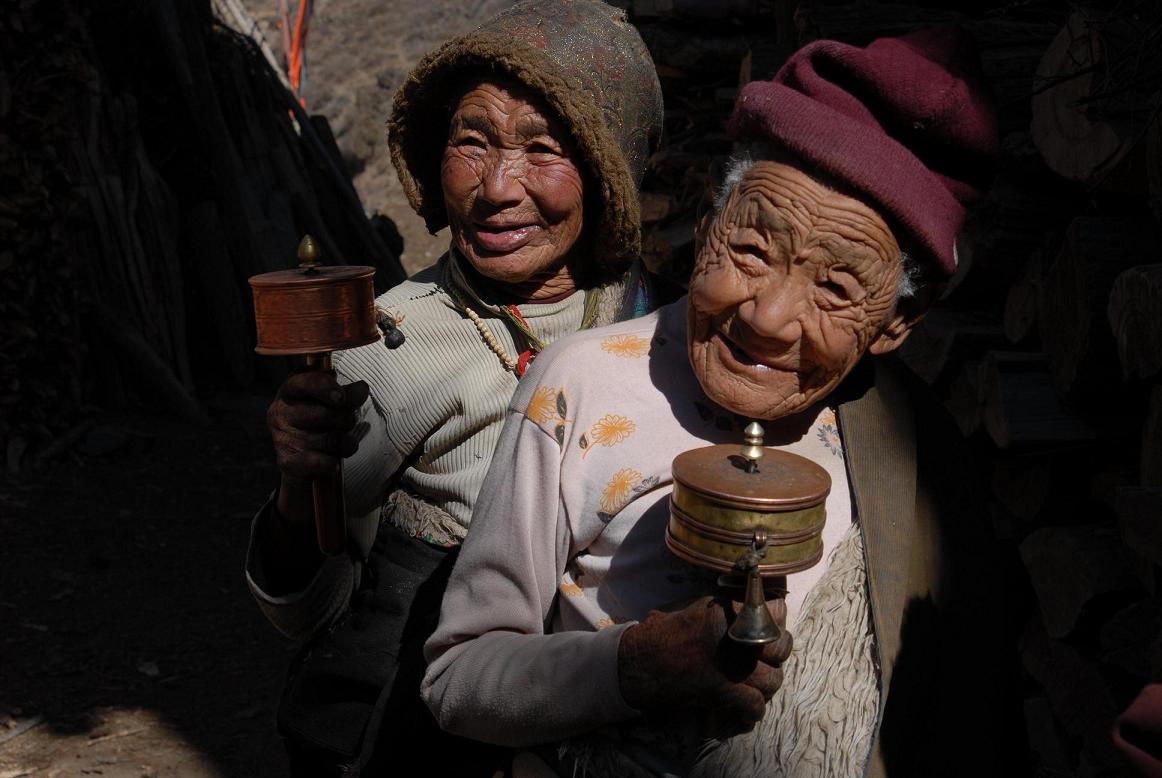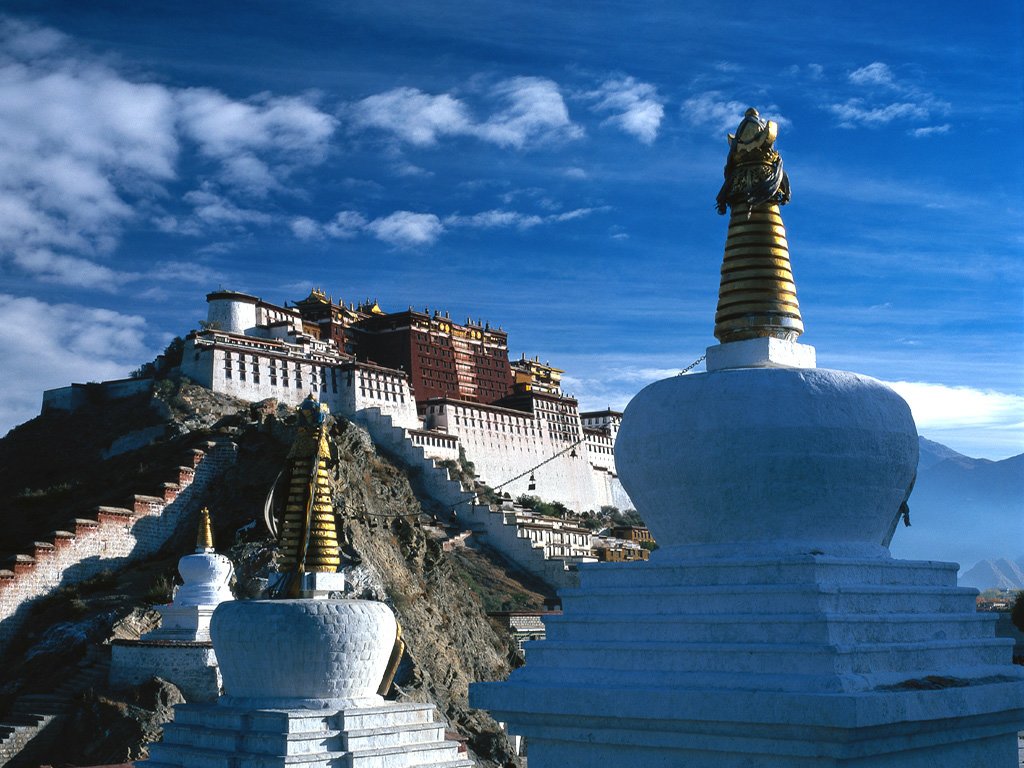

The holy city of Lhasa is the historic capital of Tibet, situated on the north bank of the Kyi-chu River, where the valley opens out to its fullest extent. To the north of the city lies an impenetrable 5,200m range, extending from Mount Gephel Utse (above Drepung in the west) to Mount Dukri Tse(above Pawangka) and Mount Sera Utse(above Sera in the east). To the south, on the far bank of the river, is the Chakyak Karpo range. There are smaller hills in the valley: the most prominent being Marpori(‘Red Mountain’) on which the Potala Palace is constructed, Chakpori(where Tibet’s medical college and temples once stood, now dominated by a radio mast), and Bonpori (surmounted by a Chinese temple dedicated to Ling Gesar). The Kyi-chu River at Lhasa meanders past several island sandbanks, among which Kunmalingka (‘Thieves’ Island’), the best known, and an adjacent island, are now the site of an extensive housing development scheme in neo Sino-Tibetan architectural style. The principal tributaries in the valley, the Dongkar, Lhalu, Nyangdren and Doked, have all been integrated into the Chera irrigation system.
Central Lhasa: orientation and attractions In downtown Lhasa there are two main north-south streets linking Chingdrol Lam with Dekyi Lam. One of these, Kharngadong Lam, leads northwards from the Dekyi Lam intersection to the Airway Hotel and the vegetable market and southwards to the Agricultural Bank of China (with an ATM machine), the Communication Hotel, the Tar Government HQ, the Lhasa Fire Brigade, the Lhasa Department Store, and various fashionable night clubs and restaurants. As the capital of the Tibet Autonomous Region in Lhasa, is one of a 1300 history ancient city. Lhasa at the north bank of the Yarlung Zangbo River tributaries, longitude 91 ° 06 'E, 29 ° 36', elevation over 3,650 meters.
Lhasa City have seven counties and one district (Chengguan District). The city's total area of nearly 30,000 square kilometers, the urban area of 59 square kilometers. The city's total population of nearly 55 million, of which the urban population of nearly 270,000, Tibetan, Han, Hui, and other 31 ethnic groups, the Tibetan population accounts for 87 percent.
"Lhasa" in the Tibetan language with the "Holy Land" or "Buddha" means, for a long time that Tibet's political, economic, cultural, religious centers, gilded, majestic and magnificent Potala Palace, the supremacy of politics and religion is the regime symbol. As early as the seventh century AD,SONGTSAN GAMBO annexation of neighboring tribes, unified Tibet, from Ya Long capital relocation logic Pose (that is today's Lhasa), the establishment of Tubo Dynasty.
On May 23, 1951, the peaceful liberation of Tibet, Lhasa City entered a new era. In 1960, the State Council officially approved Lhasa cities at prefectural level, 1982 will be the first batch of its announcement of 24 countries of the historical and cultural city.
Lhasa previously called "Anger Savimbi," Tibetan "goat" said "Anger" and "territories" that "Savimbi" Legend has it that in the seventh century Tang Princess married into Tubo, the grassland here is a beach, for the construction after the Jokhang Temple and Ramogia Monastery soil filled with goat back sleeper Tong, the temple completed, the monks to preach to people worshiping Buddha and more people around the Jokhang Temple built around it has a lot of hotels and residential housing, formed with the Jokhang Temple as the center of the old city to take shape. At the same time SONGTSAN GAMBO Also at the Hongshan expansion palace (that is the Potala Palace today), therefore, Lhasa valley plains gradually built palaces, prominent Chinese and foreign cities from the plateau formed. "Anger Savimbi" gradually turned into people's hearts in the "Holy Land", as the then Tibetan religious, political, economic, and cultural center. In most people's minds, Lhasa is the Potala Palace, the Eight Corner Street, and the Jokhang Monastery, Sera, Drepung monastery in Lhasa River and consisting of, but Tibetans believe that the strict sense "Lhasa" is referring to the Jokhang Temple and around the Jokhang Temple and the street was built up, only to the Jokhang Temple and the street was, to be a real Lhasa. Now the Lhasa area east of the city still maintains the essence of the ancient city of Lhasa.
The Potala Palace and the street was the center of Lhasa Metro North to the Sera Temple, west Doilungdeqen County. Look at the Lhasa City, post and telecommunications building, the news building, the Lhasa Hotel, Tibet guesthouses and colored buildings spread all over each other and the Senate wrong, continuous series, a new-hui. On top of overlooking the Potala Palace in Lhasa City, the urban area of Lhasa everywhere throughout the film is a tree dragon palace in the new building, but the street was a streamer were flying in the area, the ripple of mulberry smoke. Here, at the very ethnic style of the houses and streets, gathering people from all over the Tibetan Area, many of them are still wearing the traditional costumes of this nation, it seems never-hand turn from the tube and rosary clearly shows that Buddhism in fact has become a way of life.
Lhasa River Valley alluvial plain is located in the urban areas, is the world's highest-altitude cities. Tilt the terrain from east to west, the climate is semi-arid plateau temperate monsoon climate zones. The Sunshine hours 3000 hours more, therefore, "Sunlight City" reputation. The annual precipitation is 200-510 mm, concentrated in 6-9 months, and more night rain, as the rainy season. Maximum temperature 28 ° C, the minimum temperature of minus 14 ° C. Thin air, the temperature low, the temperature, dry winter and spring, and more windy. The frost-free period 100 to 120 days. |

